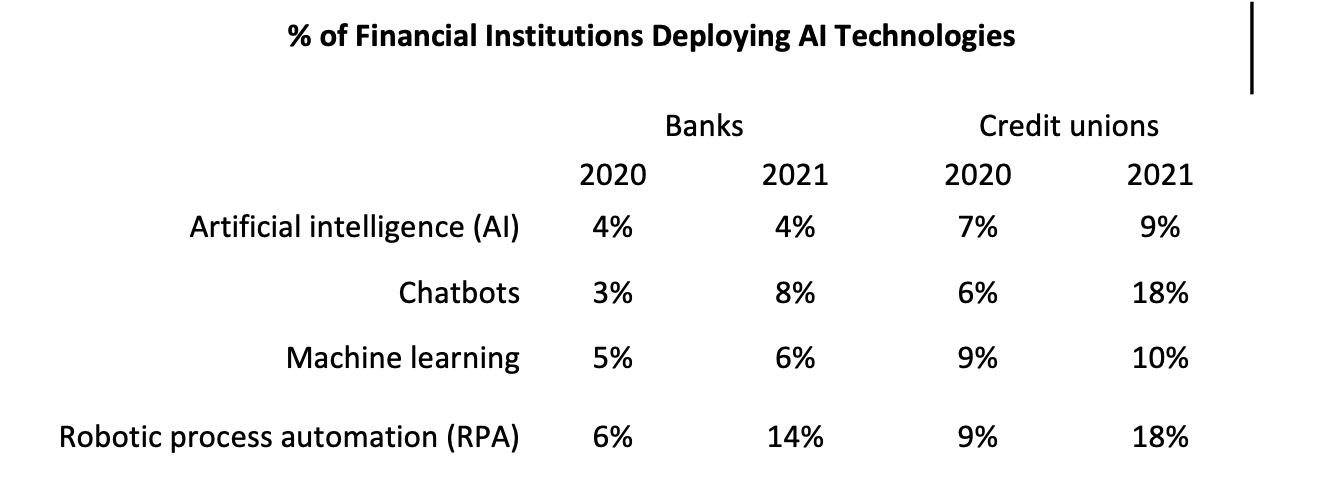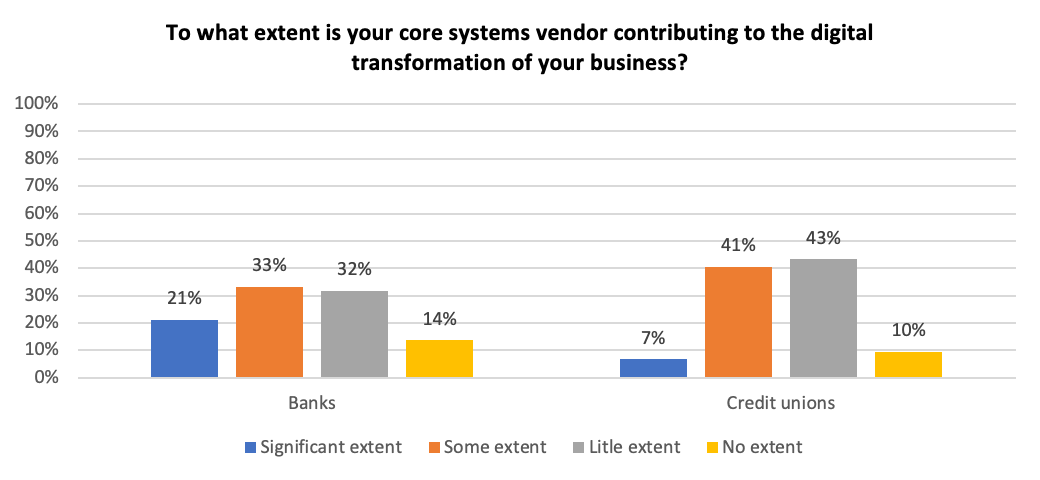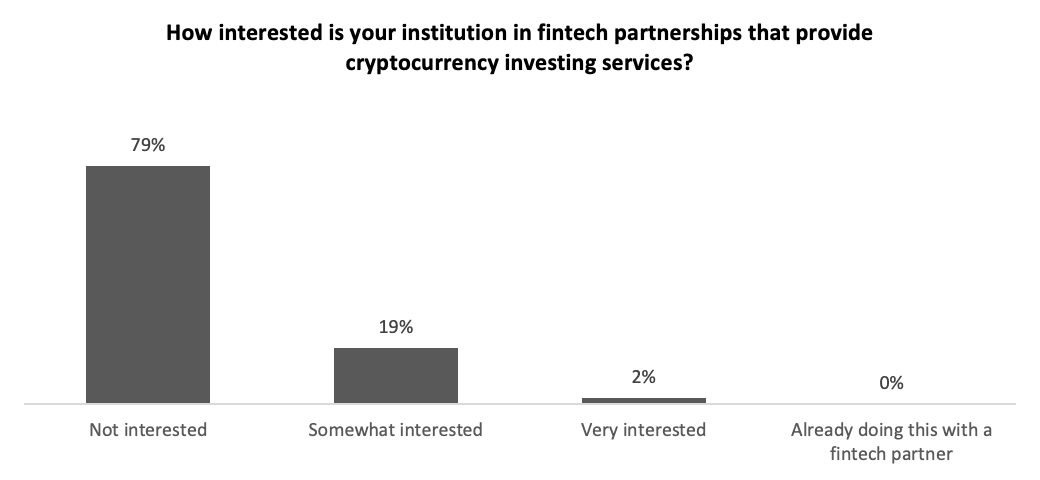OBSERVATIONS FROM THE FINTECH SNARK TANK
In the movie All The President's Men, Woodward and Bernstein meet their informant in a parking garage who tells them: "Follow the money."
If you want to know which technologies are hot in banking, you should do the same. The truly “hot” technologies in banking are the ones that financial institutions invest in—not necessarily the ones the pundits talk about.
At the end of the past seven years, Cornerstone Advisors has surveyed financial institutions to find out where their technology dollars will go in the coming year.
The Hottest Technologies in Banking
In Cornerstone’s What’s Going On in Banking 2021 study, the top five technologies for 2021 are: 1) Digital account opening; 2) Application programming interfaces (APIs); 3) Video collaboration; 4) P2P payments; and 5) Cloud computing.
1) Digital Account Opening Consumer
digital accounting opening is the most popular technology for the fourth year in a row—with banks (finally) leading the way here.
For both the retail and commercial sides of the coin, the pandemic helped shake up some long-held beliefs about the primacy of the branch—especially among bank (vs. credit union) executives—when it comes to new account opening.
Nearly half—44%—of banks and a quarter of credit unions expect to add a new or replacement consumer digital account opening system in 2021.
It’s unlikely that that many banks will actually go through with these plans this year, but a third of banks and credit unions have deployed a new consumer digital account opening system in the past three years.
Commercial digital account opening systems (for corporations and small businesses) will get a boost this year as well, as 30% of banks anticipate choosing a new system this year, up from 22% in 2020.
This shouldn’t come as a surprise. According to Cornerstone Advisors partner Quintin Sykes, “the commercial account opening and onboarding experience is one of the biggest pain points remaining in the digital experience.”
Commercial digital account opening systems are gaining in popularity among credit unions, as well. One in 10 credit unions plan to implement a new commercial account opening system in 2021—twice the number that has done so in the past three years.
2) Application Programming Interfaces (APIs)
APIs jumps from the #5 spot last year to #2 on the list for 2021, with roughly one in four institutions planning new investments.
About half of credit unions have developed or invested in APIs prior to this year, and banks are finally catching up. Going into 2021, only 30% of banks had deployed APIs, but that’s up from the 21% that had done so going into 2020.
What are they hoping to accomplish? Back in 2015, I wrote:
“APIs are about speed, agility, and personalization. You’e dead in the water if: 1) It takes nine to 12 months to integrate partners’ products and/or data, or 2) The partnership process requires significant time and resources to negotiate legal matters, revenue sharing, pricing, etc.”
Thanks for finally listening, bankers.
But there’s not enough information about banks’ use of APIs to really evaluate what’s happening here (remind me to tell the guy who does this survey to change it for 2022). Are banks deploying private, partner, or public APIs?
My guess: Mostly private.
Which means that providing an increasing set of new products and services to customers—in an attempt to keep up with the market and to ramp up new revenue streams—is probably not what banks are using APIs for.
Conclusion: The growth in API deployment among banks and credit unions is more focused on efficiency (i.e., cost and speed). That’s OK, but it still leaves the threats of fintech competitors and the opportunities from fintech partnerships unaddressed.
3) Video Collaboration
The pandemic made face-to-face interactions difficult (if not impossible), and that has accelerated banks’ and credit unions’ plans to deploy video collaboration tools.
One in four financial institutions are planning to invest for the first time in this technology in 2021. Going into 2020, only 20% of banks and credit unions had already deployed these tools—heading into 2021, that percentage is roughly 30%.
This is a signal of a big psychological shift for many financial services executives: It’s an admission that branches may not be as an important a channel as many have believed for so long.
It’s also a recognition of something I’ve been saying for a long time: Consumers’ continued use of branches has little to do with their desire to go to a physical location, and a lot to do with their desire to interact with a person.
The problem to solve: Without good video collaboration tools, it’s been hard for consumers to find the right person to talk to, and then actually interact (if and) when they do find the right person.
4) Person-to-Person (P2P) Payments
P2P payments are certainly growing in popularity among consumers, but the P2P payment replacement cycle in financial institutions is starting to wind down.
For 2021, about a quarter of banks and a fifth of credit unions expect to select a new or replacement P2P tool. That’s down from the roughly 30% who expected to deploy one in 2020, which, in turn, was down from the 35% who planned to do so in 2019.
Zelle has become the 800-pound gorilla in the space, with roughly 500 institutions currently offering its P2P tool—including nearly all of the 25 largest banks. In the first half of 2020, Zelle moved $133 billion, almost double Venmo’s transaction volume of $68 billion.
The dollar volume belies consumers’ P2P payment usage patterns, however.
The PayPal app is installed on nearly two-thirds of smartphone owners’ devices, and 40% of them say they make P2P payments through the app every week, according to Cornerstone’s consumer research.
Apple Pay, Google Pay, and Venmo are found on fewer smartphones, but among consumers that do have these apps on their phone, about a third say they use them every week to make P2P payments.
It will be interesting to see in 2021 how the introduction of Google’s Plex account will impact consumers’ P2P payment behavior.
Bottom line: P2P payments isn’t a winner-take-all game. Consumers use different apps depending on who they’re paying or getting paid by. Protecting the current B2C payment revenue stream (i.e., interchange fees) may be one reason for banks to focus on driving up their revenue-less P2P volume, but the interchange flow is being attacked from multiple angles.
5) Cloud Computing
The percentage of banks that have deployed cloud computing increased significantly in 2020, going from 32% at the end of 2019 to 40% at the end of 2020. Half of credit unions are already there.
Another quarter of credit unions—but just 17% of banks—will make first-time investments in cloud computing in 2021.
While there are still holdouts to cloud computing, the general sentiment in the industry has shifted over the past few years to the point where many (if not most) banks and credit unions believe they are on an inevitable journey to the cloud.
The challenge for the tech vendors has morphed, however, from evangelizing the cloud (with claims of faster speed-to-market and lower total cost of ownership) to presenting tangible migration strategies and realistic projections of process and cost impacts.
What About Artificial Intelligence (AI)?
For all the hype surrounding AI-based technologies like chatbots, machine learning, and robotic process automation, few financial institutions beyond the 25 largest are doing much with these tools.
Deployment of robotic process automation (RPA) increased significantly last year, however, among both banks and credit unions. In addition, the percentage of credit unions deploying chatbots tripled from 6% going into 2020 to 18% heading into 2021.

With heavy reliance on vendors for their technology applications and relatively small IT shops (compared to the top 25 banks, that it), most mid-size banks and credit unions don’t have the internal resources to experiment with and develop AI-based solutions.
Over time, this will become less of an issue as AI becomes assimilated into—or indistinguishable components of—banking applications.
Until then, however, core banking vendors are missing opportunities to help their bank and credit union clients with their innovation agendas. Just one-fifth of banks and a measly 7% of credit unions say that their core banking vendor is significantly contributing to their digital transformation agendas.

Will Banks Jump On The Crypto Bus?
Cornerstone’s consumer research has found that roughly 15% of Americans hold some form of cryptocurrency like Bitcoin. But that was three months ago.
With the price of Bitcoin soaring to $40,000 (and then losing 25% of that value over the course of a weekend, only to make it make it up two days later), it’s a good bet the number of Americans getting into crypto has increased recently.
In addition, Cornerstone estimates that consumers made more than $30 billion in retail purchases using cryptocurrencies in 2020.
Are these trends enough to push banks into providing cryptocurrency-related services?
The answer is “not yet,” but there is some movement here. Although just 2% of banks and credit unions said they were “very” interested in fintech partnerships that provide cryptocurrency investing services, about one in five said that they’re “somewhat” interested.

If banks are sincere about being “customer-centric” and listening to the “voice of the customer,” they’ll start becoming more interested. A consumer survey from NYDIG found that 80% of Bitcoin holders would move their Bitcoin to their bank if it provided secure Bitcoin storage.
Prediction for 2021: The combination of the recent regulatory guidelines concerned the provision of cryptocurrency services by banks and the run-up in the price of Bitcoin will finally lead to some forward-thinking banks and credit unions to start offering crypto investing services to their customers and members.
This article was originally published By Ron Shevlin, forbes.com.













